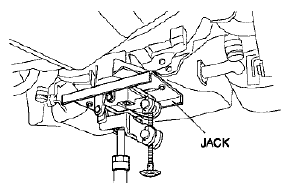Chevrolet Trax: Rear compartment floor panel replacement
Chevrolet Trax (2013-2022) Workshop Manual / Accessories & Equipment / Collision Repair / Collision repair - Repair instructions / Rear compartment floor panel replacement
Removal Procedure
WARNING: Refer to Approved Equipment for Collision Repair Warning .
WARNING: Refer to Glass and Sheet Metal Handling Warning .
- Disable the SIR system. Refer to SIR Disabling and Enabling .
- Disconnect the negative battery cable. Refer to Battery Negative Cable Disconnection and Connection .
- Remove all related panels and components.
- Visually inspect the damage. Repair as much of the damage as possible.
- Remove the sealers and anti-corrosion materials from the repair area, as necessary. Refer to Anti- Corrosion Treatment and Repair (Base) .
- Locate and mark all the necessary factory welds of the rear compartment floor panel.
- Note the number and location of weld studs for installation of the service assembly.
.gif)
Fig. 93: Drilling Factory Welds
- Drill all factory welds (1). Note the number and location of welds for installation of the service assembly.
.gif)
Fig. 94: Rear Compartment Floor Panel
- Remove the damaged rear compartment floor panel (1).
Installation Procedure
- Align the rear compartment floor panel.
.gif)
Fig. 95: Drilling Weld Holes In Rear Compartment Floor Panel
- Drill a 8 mm (5/16 in) holes for plug welding along the edges of the rear compartment floor panel as noted from the original panel (1).
- Clean and prepare the attaching surfaces for welding.
- Position the rear compartment floor panel on the vehicle.
- Verify the fit of the rear compartment floor panel.
- Clamp the rear compartment floor panel into position.

Fig. 96: Plug Welding Rear Compartment Floor Panel
- Plug the weld accordingly (1).
.gif)
Fig. 97: Drill And Required Attachments
- Drill 8 mm (5/16 in) for plug welding along the edges of the floor panel rear reinforcement, the spare wheel carrier bracket, the shipping device and the floor panel reinforcement as noted from the original panel (1).
- Clean and prepare the attaching surfaces for welding.
- Position the floor panel rear reinforcement, the spare wheel carrier bracket, the shipping device and the floor panel reinforcement on the vehicle.
- Verify the fit of the floor panel rear reinforcement, the spare wheel carrier bracket, the shipping device and the floor panel reinforcement.

Fig. 98: Plug Welding Rear Compartment Floor Panel
- Plug weld accordingly (1).
- Weld accordingly the weld studs as noted.
- Apply the sealers and anti-corrosion materials to the repair area, as necessary. Refer to Anti-Corrosion Treatment and Repair (Base) .
- Paint the repaired area. Refer to Basecoat/Clearcoat Paint Systems .
- Install all related panels and components.
- Connect the negative battery cable. Refer to Battery Negative Cable Disconnection and Connection .
- Enable the SIR system. Refer to SIR Disabling and Enabling .
READ NEXT:
 Rear wheelhouse outer panel replacement
Rear wheelhouse outer panel replacement
Removal Procedure
WARNING: Refer to Approved Equipment for Collision Repair Warning .
WARNING: Refer to Glass and Sheet Metal Handling Warning
Disable the SIR system. Refer to SIR Disabling and Enab
 Quarter outer panel sectioning
Quarter outer panel sectioning
NOTE: According to different corrosion warranties, only the
regional mandatory joining
methods are allowed.
Removal Procedure
WARNING: Refer to Approved Equipment for Collision Repair Warning .
WARNI
 Center pillar inner panel replacement
Center pillar inner panel replacement
Removal Procedure
WARNING: Refer to Approved Equipment for Collision Repair Warning .
WARNING: Refer to Glass and Sheet Metal Handling Warning .
Disable the SIR System. Refer to SIR Disabling and En
SEE MORE:
 Seat Hardware, Trim, and Upholstery - Description and
operation
Seat Hardware, Trim, and Upholstery - Description and
operation
MANUAL SEATS DESCRIPTION
NOTE: Do not attempt to change the designed seat position by
altering the designed
seat adjuster-to-floor pan anchor provisions or the seat adjuster-to-seat frame
anchor provisions. Changing the seat position could affect the performance of
the seat system.
This vehicle is
 The two types of injector drivers
The two types of injector drivers
NOTE: This is GENERAL information. This article is not intended to
be specific to any
unique situation or individual vehicle configuration. For model-specific
information see appropriate articles where available.
OVERVIEW
There are two types of transistor driver circuits used to operate electric
f
© 2019-2025 Copyright www.chevtrax.com


